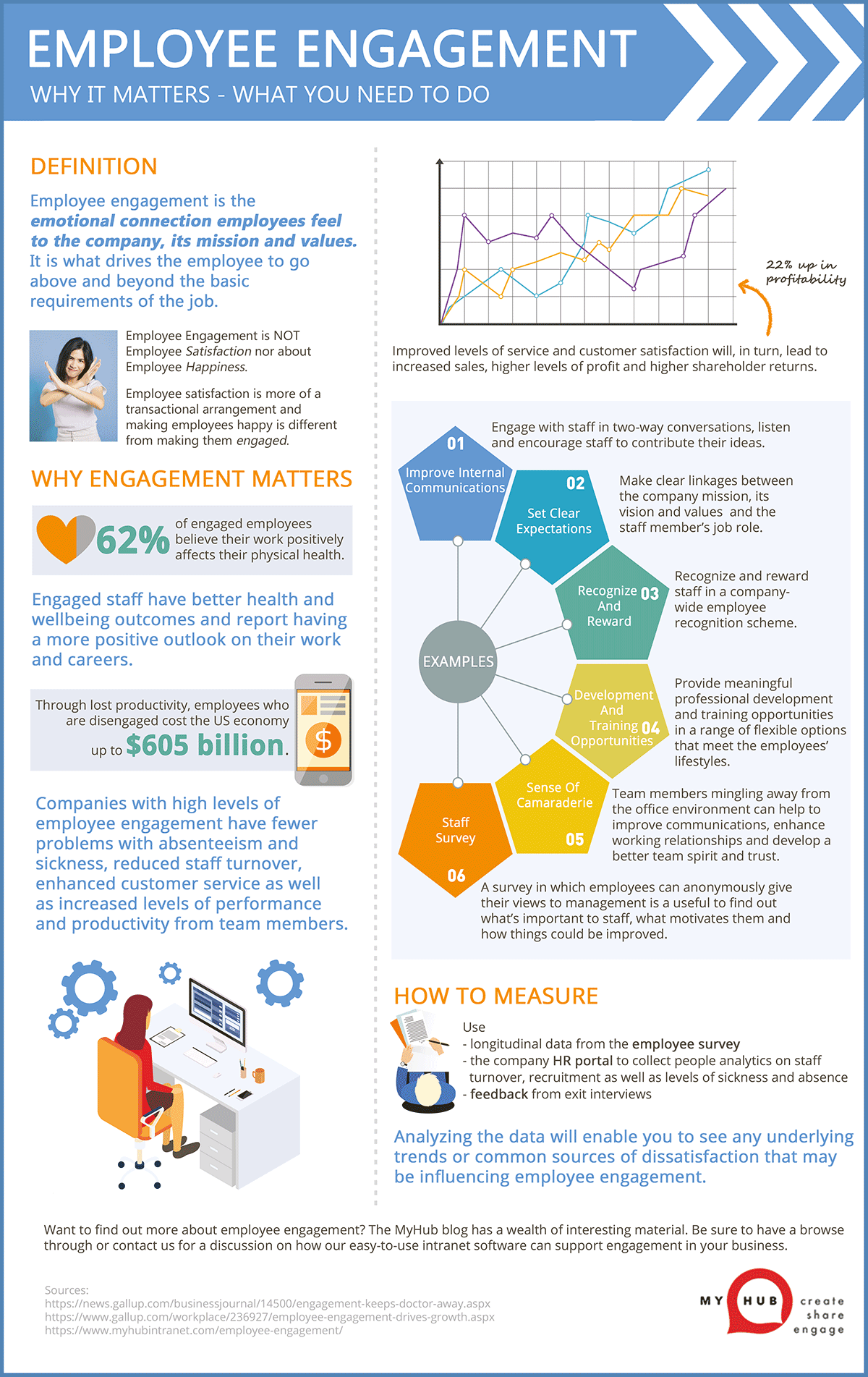What does employee engagement mean to you? Is it just another fad? Maybe you think of it as a nice-to-have initiative if you have the time and resources? Or is employee engagement, as it should be, an integral part of your business operations, leadership and management? Certainly, the cause isn’t helped by the lack of clarity over what employee engagement means. Try googling ‘employee engagement definition’ and you’ll be confronted by at least a dozen different explanations – and that’s just on page 1! It’s no wonder then that employee engagement as a concept often ends up in the too hard basket. And yet the truth is that it can have a massive impact on your organization’s bottom line. So, if you haven’t really given engagement the consideration it deserves, then it’s time to rethink your approach. And here we will make it easy for you. This post gives a comprehensive overview of what is employee engagement, why it matters and what you need to be doing.
The Definition Of Employee Engagement
Employee engagement is the emotional connection employees feel to the company, its mission and values. It’s what drives the employee to go above and beyond the basic requirements of the job.
In the definition above, we’ve distilled all the best bits of all those definitions out there. We’ve tried to come up with a simple, easy-to-understand explanation that cuts to the heart of employee engagement.
Employee engagement is, however, a complex idea and we’d be doing it a disservice if we gave the impression that a two-sentence definition is the sum total of what you need to know.
In fact, there are plenty of misconceptions out there about employee engagement. So, let’s spend some time now looking at what employee engagement is not.
What Employee Engagement Is Not
Employee Engagement Is Not Employee Satisfaction
Try not to confuse employee engagement with employee satisfaction. It’s a common mistake. Many people think that a staff member who turns up and does their 9-5 hours, performs the job to a good standard and never complains, has to be engaged, right? Well, they may well be satisfied with the job, but that doesn’t mean they’re engaged. You see, an employee who is merely satisfied won’t go the extra mile. 
Employee satisfaction is more of a transactional arrangement. If as the employer, you fulfill your side of the contract by paying the employee on time, provide the necessary tools and resources, and treat them with dignity and respect. The employee will complete their contracted hours and get the job done, but that’s it. The satisfied employee has nothing really invested in the company or has any great emotional connection.
Employee Engagement Is Not About Employee Happiness
Sure, your staff members probably love the free team lunches, subsidized gym membership and on-site yoga classes you provide. These perks and benefits may well help to make your team members happy at work and rate you highly as an employer, but making employees happy is different from making them engaged. Happy employees, or indeed satisfied ones, is not enough.
Engaged employees are those who feel energized about their work. They tend to be more proactive, productive and positive. Quite simply, they will add value to any business.
Why Engagement Matters
So, what’s all the fuss about? What difference will employee engagement make to my business? It’s a reasonable question and the simple answer is that employee engagement matters on two levels. It will make a difference both to the individual employee and the organization. Let’s find out more.
Why Employee Engagement Is Important To Staff
When it comes to the health and wellbeing of individual staff, engagement matters. Those who feel engaged, valued and appreciated at work tend to maintain more positive mental and physical health, take fewer sick days, have better relationships with colleagues and report enjoying their jobs more.
Research from Gallup tells us 62 percent of engaged employees believe their work positively affects their physical health. The results were even more telling when it comes to mental health with 78 percent of engaged workers responding that their work lives benefit them psychologically.
Employee engagement matters, therefore, because engaged staff have better health and wellbeing outcomes and report having a more positive outlook on their work and careers.
Why Staff Engagement Matters To Business
Companies with high levels of employee engagement have fewer problems with sickness and absenteeism, reduced staff turnover, enhanced customer service as well as increased levels of performance and productivity from team members. Quite simply, employee engagement will impact on your bottom line. It’s a simple equation really. Improved levels of service and customer satisfaction will, in turn, lead to increased sales, higher levels of profit and higher shareholder returns.
You don’t need to be a rocket scientist to appreciate that engaged staff can add value to your business. The truth is, according to Gallup, employees who are disengaged cost the US economy up to $605 billion through lost productivity alone. The same study revealed that only one-third of the workforce is actively engaged. This means two-thirds are at best indifferent or worse still are actively disengaged. And so, it’s easy to see how the costs of not actively engaging with staff can mount up for even small to medium-sized businesses.
What Are Examples Of Employee Engagement
So, now that we have agreed what employee engagement is and why it’s important, let’s now look at ways you can increase employee commitment and engagement.

1. Improve Internal Communications
Good staff communication is at the heart of employee engagement. However, it’s not about simply relaying information to staff. It’s more about engaging with staff in two-way conversations, actively listening to their views and feeding back on the outcomes of those conversations.
These conversations take different forms in different businesses. It could be staff roadshows, focus groups or conferences on specific issues like an employee benefits package. It could be regular team meetings or briefings in which managers and leaders actively encourage staff to contribute their ideas and suggestions. Or it could involve technology in the shape of a company blog, CEO vlog or social intranet in which staff can comment on, share and react to corporate messages.
2. Set Clear Expectations For Staff Members
Engaged employees understand the company’s bigger picture and their contribution to it.
Use the staff performance appraisal system to make clear linkages between the company mission, its vision and values, and the staff member’s job role. In addition, set clear expectations for the employee in terms of targets, goals and objectives that relate to the bigger picture.
Employees need to know how their job will advance the business. Before employees can really make an emotional connection with their employer, they need to understand how they make a difference.
And it’s essential that you feedback to staff on a regular basis – not just at annual appraisal time – how they are doing. Positive, constructive feedback is what’s required here if you want to engage with staff and get the best out of them.
3. Recognize And Reward Staff For Their Contributions
A simple thank you goes a long way. It’s a very simple idea that can have a massive impact if formalized in a company-wide employee recognition scheme. You can send a clear message to staff about how much you value them and appreciate their efforts. So, whether it’s an employee or team of the month award, a shared lunch for the team that meets an important tender deadline or simply a write-up in the staff newsletter, recognizing and rewarding staff will see the number of engaged employees increase. And don’t limit yourself to achievements inside work only. Why not give a shout out to Bob from Accounts who’s just completed his first marathon, or Anita in Marketing who’s graduated with a master’s degree.
4. Provide Development And Training Opportunities For Staff
Another way to demonstrate how much you appreciate the workforce is by providing meaningful professional development and training opportunities. In fact, it’s a win-win as your business will benefit from the increased knowledge and sharper skills the employee will bring back to the workplace.
Don’t restrict yourself though to traditional classroom-style learning or formal external programs of study. Be imaginative in your approach. Here are some ideas you could incorporate into a professional development program:
Mentoring or shadowing arrangements – either internal or external
- Online distance learning options
- Wikis
- Webinars
- How-to videos
- Podcasts
Not everyone likes to learn in the same way, so a range of flexible options that meet employees’ lifestyles and family commitments is in order. And from the organization’s perspective, these options are often low-cost. In addition, they can be completed in bite-sized chunks and won’t take the employee away from the workplace for extended periods.
5. Promote A Sense Of Camaraderie
The notion of a team-building exercise or away day still has its place in the modern workplace. Team members mixing and mingling away from the office environment can help to improve communications, enhance working relationships and develop a better team spirit and trust.
Nowadays though, lots of businesses are encouraging staff to take part in volunteering or charitable initiatives that see the organization contributing to the community in some way. Community service by way of a park clean-up, helping out at a soup kitchen or coaching elderly residents at a care home in how to use the internet help staff to feel good about themselves, their team and help grow your culture.
6. Introduce A Staff Survey
A staff survey in which employees can anonymously give their views to management is a useful and easily implemented employee engagement tool. Use the survey to find out what’s important to staff, what motivates them and how things could be improved.
It’s also an important mechanism for you to begin to measure employee engagement within your company. Over time, it will provide important longitudinal data so you can track how you are improving as well as assessing the impact of any employee engagement initiatives you might introduce. Furthermore, you can use your staff survey to compare yourself to other similar organizations and benchmark where you are at.
How To Measure Employee Engagement
It makes no sense to focus on employee engagement as a key aspiration for your business if you are not measuring progress. There are a number of metrics you can use, which together will provide a clear sense of how you are doing on the employee engagement front.
As well as the longitudinal data from the employee survey we discussed above, here are some other measures you can use:
- Use the company HR portal to collect people analytics on staff turnover, recruitment as well as levels of sickness and absence. Over time you would expect to see improvements across all areas as staff engagement increases.
- Find out your employee net promoter score. How likely are your employees to recommend your company as a great place to work to their personal network of friends and family? The simplicity of the question belies the wealth of data that sits below, especially when the results are viewed alongside the other metrics listed here.
- Analyze exit interviews. The feedback from exit interviews can provide a rich source of data on what’s happening at a grassroots level. Analyzing the data will enable you to see any underlying trends or common sources of dissatisfaction that may be influencing employee engagement.
Employee Engagement Strategies
The main takeaway from this post is that employee engagement matters. It can make a real difference to your business. Adopt some of the ideas we’ve identified in this post and you will see a return on your investment.
So, don’t leave staff engagement to chance. Develop an engagement strategy for your company with aims and objectives and clear measurable outcomes. Then review and refine so that you are continually improving. And of course, be sure to report back to staff members on progress along the way.
Jack Welch, former CEO of GE1 summed it up nicely when he gave the following quote:
There are only three measurements that tell you nearly everything you need to know about your organization’s overall performance: employee engagement, customer satisfaction, and cash flow. It goes without saying that no company, small or large, can win over the long run without energized employees who believe in the mission and understand how to achieve it. – Jack Welch
Employee Engagement Statistics
Employee Engagement Articles
If you are interested in finding out more about employee engagement, then the MyHub blog has a wealth of interesting material. Here is just a selection of what’s available. Be sure to have a browse through or contact us for a discussion on how our easy-to-use intranet software can support engagement in your business or sign up for a free 14-day intranet trial.
Employee Engagement Goals: The Best 3 Easy Steps To Get Started
Employee Engagement Survey: Kick-Start Employee Engagement In Your Business
Employee Development: New Approaches To Investing In Employees
Employee Experience: How To Attract And Retain The Best Talent
Employee Surveys: How To Get Started
8 Trends That Will Boost Your Internal Communications Strategy
Employee Motivation: Do You Know What Makes Your Staff Tick?
Employee Self-Service Portals: More Than Just A HR Resource
Engaging Generation X: The Forgotten Generation
Employee Engagement Action Plan: It’s Time For Action
Disengaged Employees: How To Recognize And Deal With This Hidden Issue
Intranet Design: Five Ways To Improve Employee Engagement
Disengaged Employees: Tips On How To Identify And Deal With Workplace Disengagement
Employee Engagement Quotations
Improving Employee Engagement: Why It’s Good For Business And How To Achieve It
Love And Loyalty: The Soft Stuff That’s Key To Business Performance
3 Easy Ways to Boost Employee Engagement Using Your Company Intranet
7 Undeniable Benefits of Employee Engagement
Don’t Let Lack of Employee Engagement Drive Down Your Profits
For your convenience, we’ve created a free download of this article What Is Employee Engagement.pdf





 Mentoring or shadowing arrangements – either internal or external
Mentoring or shadowing arrangements – either internal or external






